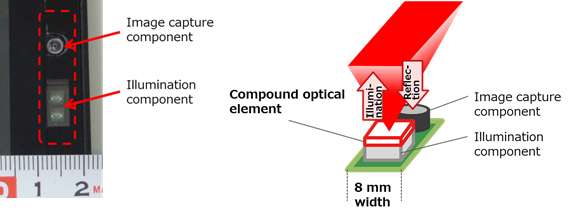
Fujitsu Laboratories has announced
development of the world's first slide-style palm vein authentication
technology. This technology is compact enough to be equipped to future tablets
and other handheld mobile devices. As tablets and other small-scale mobile
devices have become widespread, there has been interest in embedding an optical
unit for vein authentication into the narrow frames of such devices, but making
the optical unit smaller had been difficult. Fujitsu Laboratories has now taken
strides to overcome this issue. It has succeeded in developing a compact
illumination component that lights up a rectangular target area with a uniform
intensity using a single LED.
This was achieved by using a new compound optical element that applies the phenomenon of diffraction. The company has also developed a new verification technology that captures the complete pattern of a palm's veins, dividing the pattern into slices as the hand passes over the optical unit, which at a mere 8 mm wide is able to be embedded into the frames of compact mobile devices. As a result, palm vein authentication-with its superior characteristics, including highly accurate authentication and the spoof-resistance offered by biological information from within the body-can be put to wider use, such as accessing personal or other sensitive information, or using services. The expectation is that this will lead to a corresponding prevalence of highly secure mobile services.
Password-based authentication is increasingly seen as being vulnerable. Given this, biometric authentication technologies, in which a user confirms identity using a distinctive characteristic of their body or behavior, are becoming commonplace to prevent damage from data leaks or fraud. Fujitsu Laboratories has been a global leader in developing and deploying palm vein authentication technology, which has the benefits of using biological information within the body that is difficult to spoof. In recent years, as working styles evolve in a variety of industries, the use of tablets and other mobile devices is spreading, and the devices are getting smaller. Given this, there has been a desire to equip these devices with even smaller palm vein authentication technology, which further improves security and simple operability, enabling corporate customers to use with peace of mind.
Palm vein authentication technology utilizes images captured by illuminating a palm with the safe near-infrared band light, which passes easily through the body, and reads vein patterns from the captured image. Accordingly, a palm vein authentication device's optical unit consists chiefly of an illumination component and an image capture component. In order to uniformly illuminate the entire palm, the illumination component, the widest part of the optical unit, is arranged to surround the image capture component. The issue, however, has been in making the component smaller. Moreover, if the image capture component is made smaller, the area that can be read on the palm veins becomes narrower, making authentication more difficult because the read area in palm veins is significantly different with every capture image when registering or verifying. As a result, it has been difficult to create technology that both enables the optical unit to be smaller and achieves accurate authentication.
In this world's first slide-style palm vein authentication technology, Fujitsu has miniaturized the optical unit to a mere 8 mm in width, allowing it to fit within the touch panel of mobile devices. This enables authentication simply by sliding one's fingers across the touch panel. Key features of the technology are as follows:
1. Optical design technology for a uniformly lit, rectangular illumination area
Fujitsu Laboratories developed a compound optical element that utilizes optical diffraction to both scatter and focus light (Figure 1). The light radiated from the LED is diffracted to illuminate upwards diagonally, enabling illumination with uniform intensity over a rectangular area that is wider than the illumination component. By diffracting the light with uniform intensity at the rectangular area for image capture, the number of LEDs can be reduced. Moreover, by creating a structure in which the illumination component and the image capture component can be arranged in one row, Fujitsu Laboratories was able to create a size small enough to fit within the narrow width of a mobile device frame.
2. Slide-style input with a finger stroke of the touch-panel, and an authentication algorithm
Users slide their fingers across the touch panel of the mobile device, and as the user's palm passes over the optical unit, which continuously captures images of the palm. At the same time, coordinate data obtained from the touch panel is also continuously recorded (Figure 2). Even though the optical unit's compact size results in a smaller capture area, because the hand passes over the optical unit, the pattern of palm veins is divided up for reading, enabling the entire palm vein pattern to be used for authentication. The guides make the captured area on the palm easier to reproduce. In addition, Fujitsu Laboratories developed a new algorithm for authenticating the divided-up palm vein patterns, verifying data using such features as image selection (false accept rate of 0.001%, and a one-retry false reject rate of 0.01%).
Using this newly developed technology, Fujitsu Laboratories has reduced the width of the optical unit for palm vein authentication to a mere 8 mm, achieving a size small enough to fit in the frame of tablets or other compact mobile devices that have narrow borders. Furthermore, combining a slide action with an authentication algorithm means verification just as dependable as current optical units.
Fujitsu Laboratories plans to continue refining its optical units and authentication algorithms with the goal of practical implementation of slide-style palm vein authentication technology during fiscal 2017. The company looks forward to expanding the use of palm vein authentication into new situations, thanks to new miniaturization techniques such as the compound optical element.

 Previous page
Previous page Back to top
Back to top







